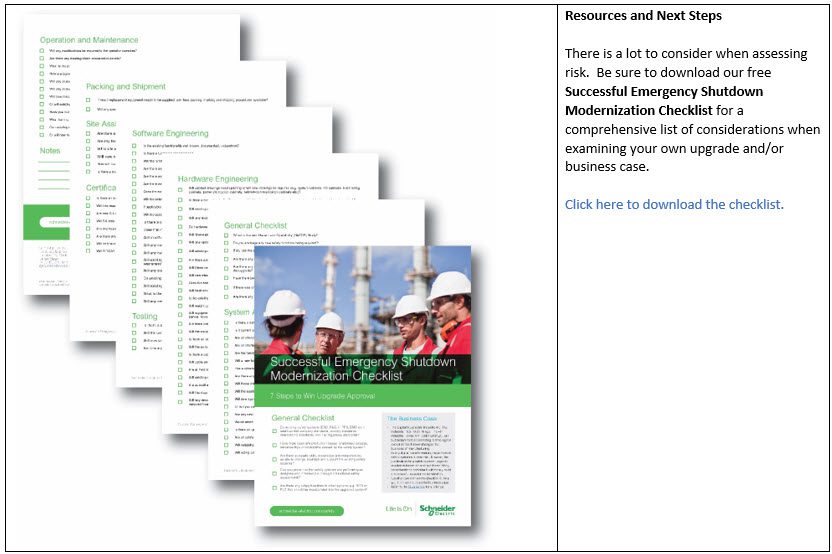Modernizing Emergency Shutdown Systems Step 6: Focus on the Benefits
Credit to Author: Steve Elliott| Date: Mon, 05 Aug 2019 12:00:27 +0000
 The Digital Revolution. Industry 4.0. The Industrial Internet of Things. The 4th Industrial Revolution. Call it what you will but today’s fast-accelerating technological evolution has forever changed the business of manufacturing.
The Digital Revolution. Industry 4.0. The Industrial Internet of Things. The 4th Industrial Revolution. Call it what you will but today’s fast-accelerating technological evolution has forever changed the business of manufacturing.
In any digital transformation, investment in safety systems is essential. However, the justification for a safety system upgrade is seldom based on a single factor. Many considerations combine to ultimately build a successful case for modernization. I once presented a manager with two choices: Upgrade the legacy safety system or wait until something happens and go out of business. I know that sounds a bit extreme, but it’s not always possible to restart operations after an outage!
This post will discuss the important step of finding and focusing on the benefits as you build an effective business justification and win that all-important approval to successfully secure money and resources for your new safety model.
Focus on the Carrot
 There’s an old idiom that refers to the practice of offering a combination of reward and punishment to induce a desired behavior. It’s called the “carrot and the stick” and conjures up a scene of a cart driver dangling a carrot in front of a mule and holding a stick behind it. The carrot is the mule’s reward; while the stick is something the mule would like to avoid. When justifying safety system upgrades, I am reminded of the carrot and stick approach to motivating decision makers.
There’s an old idiom that refers to the practice of offering a combination of reward and punishment to induce a desired behavior. It’s called the “carrot and the stick” and conjures up a scene of a cart driver dangling a carrot in front of a mule and holding a stick behind it. The carrot is the mule’s reward; while the stick is something the mule would like to avoid. When justifying safety system upgrades, I am reminded of the carrot and stick approach to motivating decision makers.
When building a business case, it is all too easy to focus on the negatives by listing all potential downsides and the risk / consequence to the business of not implementing an upgrade. While these concerns shouldn’t be overlooked, the negative approach leaves a long-lasting disconcerting image in the mind and a sour taste in the mouth of the decision makers. I’ve found that many companies realize that this approach is ineffective. Decision makers are more motivated to do a better job for their companies when they can highlight the potential upsides and value to the business.
The goal of the new project is not to compare old and new systems but to focus on the gains of the project investments. In general, the outcome needs to create additional value to the organization, either reducing bottom line costs, improving operating margins or creating increased revenue. These are all great rewards for the business and something almost everyone can easily get behind.
TIP: Sometimes the benefits of upgrading are intangible and difficult to quantify in an ROI calculation. In this case, it is still important to at least capture and document the intangible benefits to further build understanding, importance and significance to the business case and organization. In other words: Document the benefits, even if you can’t easily quantify them.
Break the Cost Fixation
It is only natural to want to keep upgrade project costs to a minimum and spend only what is required. At the end of the day there are only 3 choices:
- Spend nothing, do nothing
- Spend a little, do the minimum
- Spend a lot, do everything
Nobody will be surprised at the desire to choose option 1! However, this may not be sustainable, as at some point in time, something will break and then investment will be forced. If unscheduled, this can have a damaging effect on planned activities, resources and budget. No-one likes unexpected bombshells. Read Modernizing Emergency Shutdown Systems Step 2: Build Consensus.
Manufacturing operations have little incentive to replace something that is operating. Age alone is rarely a reason enough to upgrade, which is why there is so much aging infrastructure still operating today! The challenge is delivering enough benefits to justify the expenditure. How much improvement is enough? What is the associated cost and what do I get in return? Is there a correlation between $1 investment to $X return?
Doing a “replacement in kind” provides little or no benefit. There needs to be additional value created for the business, otherwise why upset the status quo? The key is to recognize that a change of one or more generations of hardware and software brings with it the opportunity to make an investment leading to future benefits. It is also important to remember the desire to minimize cost potentially reduces improvements to be gained from the upgrade effort. This is a great place to focus on the benefits. The upgrade should provide better performance, better reliability and better availability.
Benefit: Increased Reliability and Uptime
Increased reliability and uptime are both key beneficial aspects to highlight. Many older safety systems do not fully support the diagnostic capabilities of newer instruments and equipment. Newer instruments provide more diagnostic information to the safety system and asset management system, which helps to quickly identify the root cause of maintenance issues. In addition, the internal diagnostics built into modern safety systems, together with modern software applications and mobile “go anywhere, know anywhere” technologies, help avoid and certainly minimize troubleshooting time.
Benefit: Improved Operational Performance, Reduced Operating Costs
When looking for improved cash flows and formulating cost justifications, it is worth taking a moment to explore potential operational improvements. Take the time to talk to operations, maintenance and engineering departments who daily operate the plant / process. Beneficial ROI opportunities tend to be plentiful when hearing their perspectives.
For example, one major oil and gas operating company needed to upgrade more than 80 burner management systems as part of a program to update the furnaces to meet National Fire Protection Association (NFPA) regulations. As part of the upgrade, the team identified ways of improving the operation of the furnaces and updated the standard operating procedures, which resulted in more efficient and effective operation of the furnaces.
Benefit: Innovation Opportunities
The objective of a modernization project should not be to simply replace, but rather to innovate and explore all areas of potential enhancement. Many improvement opportunities are driven by compliance to safety standards and recognized best practices. But upgrading the safety system should be an opportunity to enable the manufacturing operation to be more sustainable, efficient and safer for the remaining operating life of the plant. Upgrading the safety system must unlock new opportunities.
For example, the improved contextualization of priority alarms and situational awareness graphics increase operator efficiency and result in faster, better decision making and incident avoidance. The specific impact on ROI should include the likelihood of incident avoidance, production quality / waste product rework product cycles, rate improvements and reduced operational downtime.
For another example, the use of modern digital automated logic testing applications significantly reduces the man power and time required to perform:
- Validation of upgraded / migration application logic functionality
- Testing efforts (pre-FAT, FAT, SAT)
- Start-up durations
- Validating logic changes / modifications and modification packs
- Loop testing and commissioning
- Periodic proof testing
- Periodic logic revalidation
- Operator training
Such automated tools enhance test quality, improve consistency (the same test, every time), increase accuracy and test coverage (give more confidence in the application logic), increase integrity (can test for both positive and negative outcomes) and complement traditional manual tests. Unless the safety system is upgraded, it may not be possible to capitalize on these potential new benefits.
In one case, the use of automated digital trip analysis tools reduced the time to investigate plant trips and outages, returning the plant back to production sooner and back to making money!
Benefit: Unlock New Potential
There are many benefits to be realized from modern safety systems that create new ways to improve top line and bottom line financial performance. Some examples include:
- Online upgrades can now be performed, which means you never have to stop the safety system, so product operations aren’t interrupted.
- The ability to have more flexible implementation architecture (copper, fiber, ethernet, central, distributed, remote, etc.) means you can optimize equipment layout, reduce field cabling, have less interfaces, reduce maintenance costs, etc.
- Better controller performance:
- You can incorporate more applications in a single controller, which equals less footprint, less capital cost, less operational cost, less maintenance, less spares, etc.
- You can do more complex safety logic (e.g. dynamic safety calculations where safety set points change according to dynamically calculated risk criteria).
- Better ability to future-proof your investment (universal safety I/O, expand online, upgrade online, cyber readiness, etc.).
- Deeper, richer diagnostic environment and easier HART integration reduce troubleshooting times, reduce maintenance activities and costs, etc.
Benefit: Reduced Energy Costs
Modern equipment typically consumes less power and generate less heat than that of older generations. This has potential to reduce energy costs.
Benefit: Go Virtual
This is also a good time to consider the potential advantages of virtualization and the associated lifecycle benefits for the future operating life of the system, including:
- Fewer computers are required, reducing the cost of hardware.
- Less dependency on hardware versions, operating system versions, etc. reduces maintenance and support costs.
- A smaller footprint reduces energy consumption and heating / cooling requirements, as well as reduces the space required, which is often at a premium.
- New servers can be easily added to adapt to changing needs.
In the next post, we will take a closer look at Step 7 – Pitch to Win.
Did you miss the first posts in this series? Click below to read them now.
Modernizing Emergency Shutdown Systems: 7 steps to approval
Modernizing Emergency Shutdown Systems: Step 1 Funding Approach
Modernizing Emergency Shutdown Systems: Step 2 Build Consensus
Modernizing Emergency Shutdown Systems: Step 3 Decide When
Modernizing Emergency Shutdown Systems: Step 4 Use a Risk Approach
Modernizing Emergency Shutdown Systems: Step 5 Define a Winning ROI
For further reading:
Download IIoT for Process Safety White Paper
The post Modernizing Emergency Shutdown Systems Step 6: Focus on the Benefits appeared first on Schneider Electric Blog.

